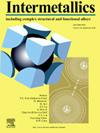High Bs nanocrystalline alloy with excellent soft magnetic properties achieved based on regulating amorphous matrix structure via two-step annealing
IF 4.3
2区 材料科学
Q2 CHEMISTRY, PHYSICAL
引用次数: 0
Abstract
Mastering the intrinsic crystallization mechanism of structural evolution is the key to improving comprehensive soft magnetic properties. This study systematically investigated the effects of conventional annealing (CA) on the microstructure, crystallization behavior, and soft magnetic properties of the Fe81.3Si3–xB10.7P3Cu1C1Nix (x = 0, 0.7, 1.4, 2.1, and 2.8) alloy ribbons comparing with those subjected to two-step annealing (TSA). All ribbons exhibited good amorphous forming ability (AFA) and had a large annealing window (>110 K), assuring the control of the precipitation process of α-Fe nanocrystals. The atomic rearrangements at the pre-annealing stage of the structural relaxation increased the cluster nucleation density of the amorphous matrix. TSA significantly affected the coercivity (Hc), effective permeability (μe), and grain size (D). The Fe81.3Si3–xB10.7P3Cu1C1Ni1.4 alloy ribbon obtained using TSA exhibited excellent magnetic properties with a Bs of up to 1.82 T, a low Hc of 2.3 A/m, and a high μe of up to 12500 at 1 kHz, which was related to the wide and smooth magnetic domain structure. Therefore, these findings could provide a novel guide for performance optimization to meet the applications of miniaturized and high-frequency electronic components.
通过两步退火调节非晶态基体结构,获得了具有优异软磁性能的高硼纳米晶合金
掌握结构演化的内在结晶机制是提高综合软磁性能的关键。本研究系统地研究了常规退火(CA)与两步退火(TSA)对Fe81.3Si3-xB10.7P3Cu1C1Nix (x = 0,0.7, 1.4, 2.1和2.8)合金带的组织、结晶行为和软磁性能的影响。所有条带均具有良好的非晶成形能力(AFA)和较大的退火窗口(>110 K),保证了α-Fe纳米晶析出过程的可控。结构弛豫预退火阶段的原子重排增加了非晶基体的团核密度。TSA对矫顽力(Hc)、有效磁导率(μe)和晶粒尺寸(D)有显著影响。采用TSA法制备的Fe81.3Si3-xB10.7P3Cu1C1Ni1.4合金带具有优异的磁性能,在1 kHz时,其磁畴结构宽而光滑,磁畴的磁畴强度高达1.82 T,磁畴强度低至2.3 a /m,磁畴强度高至12500 μe。因此,这些发现可以为满足小型化和高频电子元件应用的性能优化提供新的指导。
本文章由计算机程序翻译,如有差异,请以英文原文为准。
求助全文
约1分钟内获得全文
求助全文
来源期刊

Intermetallics
工程技术-材料科学:综合
CiteScore
7.80
自引率
9.10%
发文量
291
审稿时长
37 days
期刊介绍:
This journal is a platform for publishing innovative research and overviews for advancing our understanding of the structure, property, and functionality of complex metallic alloys, including intermetallics, metallic glasses, and high entropy alloys.
The journal reports the science and engineering of metallic materials in the following aspects:
Theories and experiments which address the relationship between property and structure in all length scales.
Physical modeling and numerical simulations which provide a comprehensive understanding of experimental observations.
Stimulated methodologies to characterize the structure and chemistry of materials that correlate the properties.
Technological applications resulting from the understanding of property-structure relationship in materials.
Novel and cutting-edge results warranting rapid communication.
The journal also publishes special issues on selected topics and overviews by invitation only.
 求助内容:
求助内容: 应助结果提醒方式:
应助结果提醒方式:


